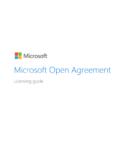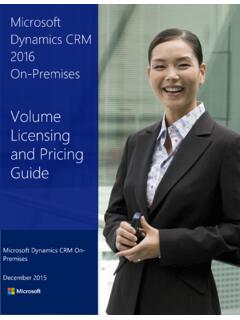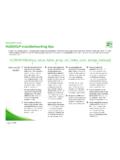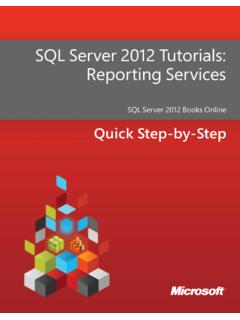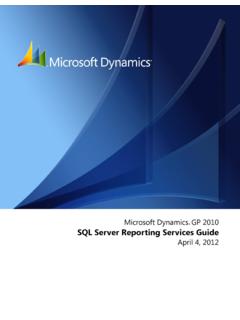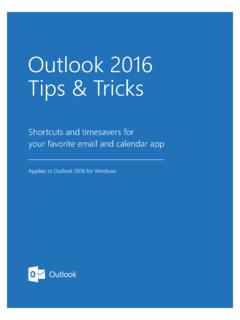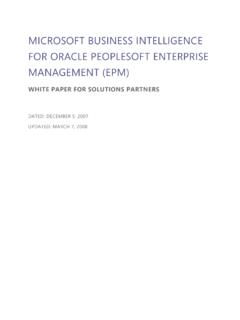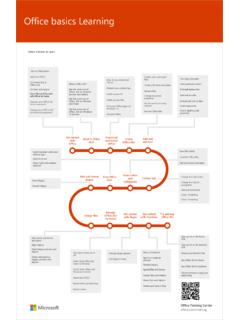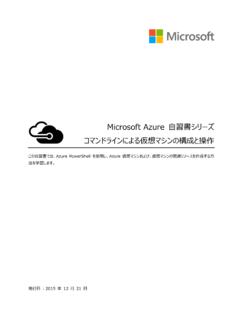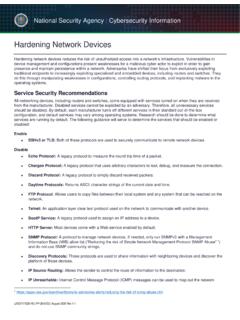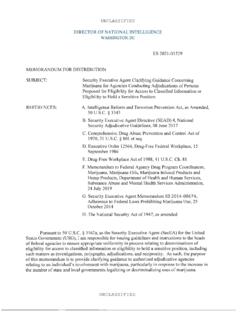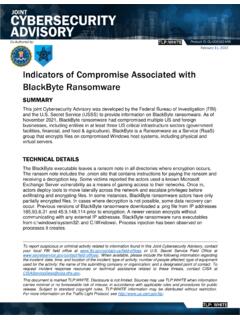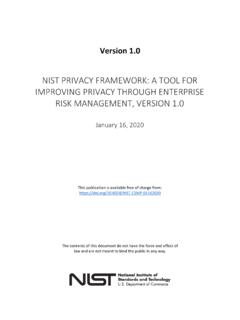Transcription of Mitigating Pass-the-Hash (PtH) Attacks and Other ...
1 Mitigating Pass-the-Hash (PtH) Attacks and Other Credential Theft Techniques Mitigating the risk of lateral movement and privilege escalation 1 Mitigating Pass-the-Hash (PtH) Attacks and Other Credential Theft Techniques This document is for informational purposes only. MICROSOFT MAKES NO WARRANTIES, EXPRESS, IMPLIED, OR STATUTORY, AS TO THE INFORMATION IN THIS DOCUMENT. This document is provided as-is. Information and views expressed in this document, including URL and Other Internet Web site references, may change without notice. You bear the risk of using it. Copyright 2012 Microsoft Corporation. All rights reserved. The names of actual companies and products mentioned herein may be the trademarks of their respective owners. 2 Authors Patrick Jungles Microsoft Trustworthy Computing Aaron Margosis Microsoft Consulting Services Mark Simos Microsoft Consulting Services Laura Robinson Microsoft IT Information Security and Risk Management Roger Grimes Microsoft IT Information Security and Risk Management Contributors Microsoft Office 365 Security Microsoft Windows Security and Identity Team Joe Bialek Benjamin Godard Paul Rich Justin Hendricks Nathan Ide Paul Leach Paul Miller Michiko Short Microsoft Trustworthy Computing Adam Shostack David Seidman Ellen Cram Kowalczyk Georgeo Pulikkathara Graham Calladine Ian Hellen John Lambert Mike Reavey Jonathan Ness Mark Cartwright Mark Oram Tim Rains Matt Thomlinson Ryan Heffernan Sean Krulewitch 3 Microsoft Consulting Services Al Tieman Andrew Idell David Hoyle Fernando Cima Janwillem Kok Jerry Cochran Jiri Formacek Matt Kemelhar Michael Howard Nate Morin Patrick Arnold Sean
2 Finnegan Interactive Entertainment Business Mark Novak Microsoft Server and Tools Business Dean Wells Microsoft IT Information Security and Risk Management Bret Arsenault Brian Fielder Eric Leonard Vexcel Rich Levy 4 Contents Executive Summary .. 6 7 What is the PtH attack?.. 8 How is a PtH attack performed?.. 11 Why can t Microsoft release an update to address this issue? .. 15 How can your organization mitigate the risk of a PtH attack? .. 16 mitigation 1: Restrict and protect high privileged domain accounts .. 19 mitigation 2: Restrict and protect local accounts with administrative privileges .. 20 mitigation 3: Restrict inbound traffic using the Windows 20 Additional recommendations .. 21 Do not allow browsing the Internet with highly privileged 21 Remove standard users from the local Administrators group .. 21 Configure outbound proxies to deny Internet access to privileged accounts .. 22 Ensure administrative accounts do not have email accounts.
3 22 Use remote management tools that do not place reusable credentials on a remote computer s memory .. 23 Avoid logons to less secure computers that are more likely to be compromised .. 23 Update applications and operating systems .. 23 Limit the number and use of privileged domain accounts .. 23 Secure and manage domain controllers .. 24 Remove LM hashes .. 24 Analysis of Other potential mitigations .. 25 Disable the NTLM protocol .. 25 Smart cards and multifactor authentication .. 26 Jump servers .. 26 Rebooting workstations and servers .. 27 Additional technical information .. 27 Trust levels and credential theft .. 27 Other credential theft Attacks .. 28 5 Kerberos Pass the Ticket Attacks .. 29 Windows authentication protocols and credential types .. 30 Windows authentication protocols .. 31 Windows authentication .. 33 Terminology: authentication, credentials, and authenticators .. 33 Credentials in Windows operating 33 Logon type 40 Common administrative tasks and remote credential 41 Summary.
4 46 Appendix A: Step-by-step instructions to mitigate PtH Attacks .. 47 mitigation 1: Restrict and protect high privileged domain accounts .. 47 Task 1: Separate administrative accounts from user accounts for administrative personnel .. 48 Task 2: Create specific administrative workstation hosts for administrators .. 49 Task 3: Restrict server and workstation logon access .. 54 Task 4: Disable the account delegation right for privileged accounts .. 59 mitigation 2: Restrict and protect local accounts with administrative privileges .. 60 Task 1: Enforce local account restrictions for remote access (Windows Vista and later Windows operating systems) .. 61 Task 2: Deny network logon to all local accounts .. 65 Task 3: Create unique passwords for privileged local accounts .. 68 mitigation 3: Restrict inbound traffic using the Windows 69 Using a GPO to set up Windows Firewall rules .. 71 Appendix B: Pass-the-Hash (PtH) attack FAQs.
5 75 Appendix C: Definitions .. 78 Appendix D: 79 Appendix E: Document Update .. 80 6 Executive Summary A Pass-the-Hash (PtH) attack uses a technique in which an attacker captures account logon credentials on one computer and then uses those captured credentials to authenticate to Other computers over the network. A PtH attack is very similar in concept to a password theft attack, but it relies on stealing and reusing password hash values rather than the actual plaintext password. The password hash value, which is a one-way mathematical representation of a password, can be used directly as an authenticator to access services on behalf of the user through single sign-on (SSO) authentication. To use this technique, an attacker must first obtain local administrative access on a computer in the organization to steal credentials from the computer's disk and memory. This level of privilege allows the attacker to not only obtain password hashes, but also any Other credentials stored on the compromised computer.
6 An attacker can obtain local administrative access by either compromising the built-in local administrator account, a domain account with membership in the local administrators group, or another local account that can be used to install drivers, applications, and execute applications that allow direct interaction with the hard disk or volatile memory. The PtH technique allows an attacker who has compromised a single computer to gain access to connected computers, including domain controllers and Other servers storing sensitive information. For this reason, Mitigating the risk of PtH Attacks and Other similar credential theft Attacks can significantly improve the security posture of an Active Directory environment. The PtH attack is one specific type of credential theft and reuse attack. While this document focuses on Windows operating systems, Other operating systems are vulnerable to similar credential theft and reuse Attacks .
7 These Attacks have become common and concern many of our customers. This document is designed to assist your organization with defending against these types of attack. Information about how PtH Attacks and related credential theft attack techniques work is provided, as well as how your organization can use security mechanisms in Windows operating systems to mitigate the risk of these Attacks . 7 Introduction As the tools and techniques for credential theft and reuse Attacks like the Pass-the-Hash (PtH) attack improve, malicious users are finding it easier to achieve their goals through these Attacks . The PtH attack is one of the most popular types of credential theft and reuse attack seen by Microsoft to date, although this white paper also discusses Other similar Attacks . Other credential theft Attacks include key logging and Other plaintext password capture, passing tickets, token impersonation, and man-in-the-middle Attacks .
8 We have recently observed the active use of PtH techniques by determined adversaries in targeted Attacks . For more details, see the Microsoft white paper Determined Adversaries and Targeted Attacks1 which includes information about attacker motivation, goals, and alternative attack methods that are not discussed in this white paper. Attackers can use multiple tools and techniques to perform a credential theft and reuse attack, some of which are easily available from the Internet. While this paper focuses on Windows operating systems, attackers can perform credential theft and reuse Attacks on any operating system and these Attacks are a threat to Other platforms as well. PtH Attacks and similar credential theft Attacks take advantage of the same flexibility of single sign-on (SSO) authentication mechanisms that allow users to seamlessly authenticate to network resources. SSO mechanisms require the computer to maintain a copy of authentication credentials to be used on behalf of the user for certain tasks, such as checking email or accessing a remote resource.
9 Without these credentials, the computer would need to prompt the user to enter their authentication credentials every time a network authentication is performed. A PtH attack can have a significant impact on an environment managed by Active Directory. If successful, the attack may result in the compromise of privileged administrative accounts, such as those that are members of the Domain Admins or Enterprise Admins groups. For these reasons, it is critical to any organization s security posture to evaluate the risk of PtH Attacks and similar credential theft Attacks , and to implement mitigations to reduce or manage these risks. The recommended mitigations in this paper are intended to help you significantly minimize the risk and impact of PtH Attacks and Other credential theft Attacks in your organization. We also recommend educating decision makers involved in business risk management and administrative staff with this information.
10 This especially applies to administrators who require Domain Administrator or equivalent accounts for their daily jobs. The first part of this document discusses PtH Attacks against Windows operating systems, how the attack is performed, and recommends mitigations for PtH Attacks and 1 8 similar credential theft Attacks . More technical details and background information is provided in the "Additional technical information" section. The remainder of this document contains step-by-step instructions on deploying the mitigations described in the first part of the document. What is the PtH attack? The Pass-the-Hash (PtH) attack and Other credential theft and reuse types of attack use an iterative two stage process. First, an attacker must obtains local administrative access on at least one Second, the attacker attempts to increase access to Other computers on the network by: 1.
